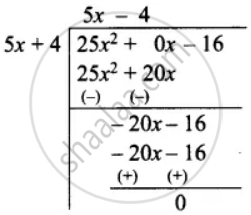Advertisements
Advertisements
प्रश्न
The base of a parallelogram is (5x + 4). Find its height if the area is 25x2 – 16
उत्तर
Let the height of the parallelogram be “h”
Base of the parallelogram = 5x + 4
Area of a parallelogram = 25x2 – 16
∴ Base × Height = 25x2 – 16
(5x + 4) × h = 25x2 – 16
h = `(25x^2 - 16)/(5x + 4)`
h = `((5x)^2 - 4^2)/(5x + 4)`
= `((5x + 4)(5x - 4))/(5x + 4)`
Height of the parallelogram = 5x – 4

APPEARS IN
संबंधित प्रश्न
Divide the polynomial p(x) by the polynomial g(x) and find the quotient and remainder in each of the following
p(x) = x3 – 3x2 + 5x – 3, g(x) = x2 – 2
Check whether the first polynomial is a factor of the second polynomial by dividing the second polynomial by the first polynomial
t2 – 3, 2t4 + 3t3 – 2t2 – 9t – 12
Give examples of polynomials p(x), g(x), q(x) and r(x), which satisfy the division algorithm
deg p(x) = deg q(x)
Apply division algorithm to find the quotient q(x) and remainder r(x) on dividing f(x) by g(x) in the following f(x) = 4x3 + 8x2 + 8x + 7, g(x) = 2x2 − x + 1
What must be subtracted from the polynomial f(x) = x4 + 2x3 − 13x2 − 12x + 21 so that the resulting polynomial is exactly divisible by x2 − 4x + 3 ?
Find all zeros of the polynomial 2x4 + 7x3 − 19x2 − 14x + 30, if two of its zeros are `sqrt2` and `-sqrt2`.
Find the quotient and remainder of the following.
(4x3 + 6x2 – 23x + 18) ÷ (x + 3)
Find the quotient and remainder of the following.
(−18z + 14z2 + 24z3 + 18) ÷ (3z + 4)
What will the quotient and remainder be on division of ax2 + bx + c by px3 + qx2 + rx + s, p ≠ 0?
If on division of a non-zero polynomial p(x) by a polynomial g(x), the remainder is zero, what is the relation between the degrees of p(x) and g(x)?
